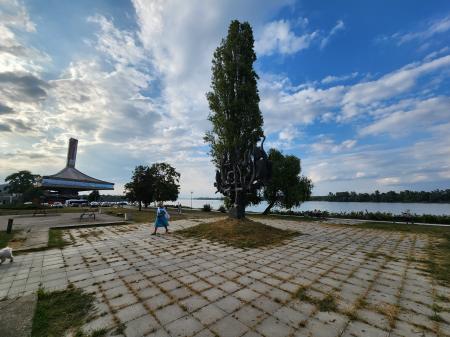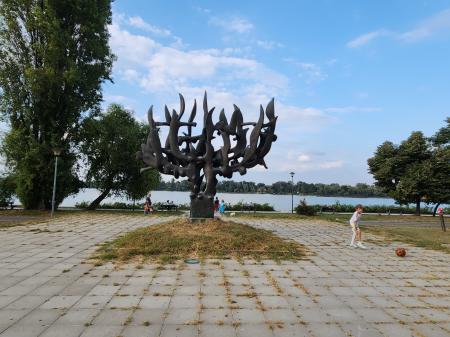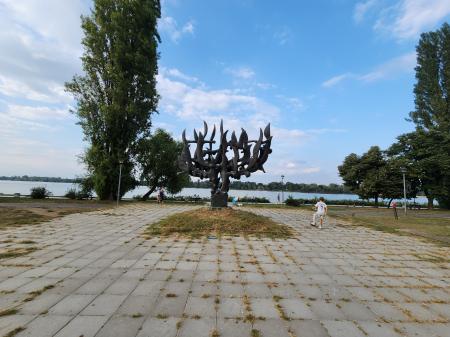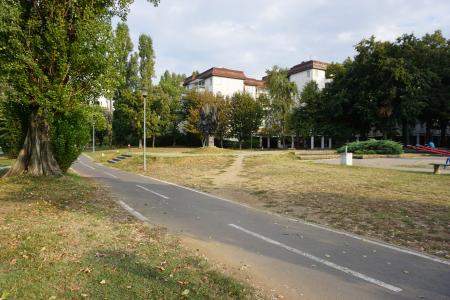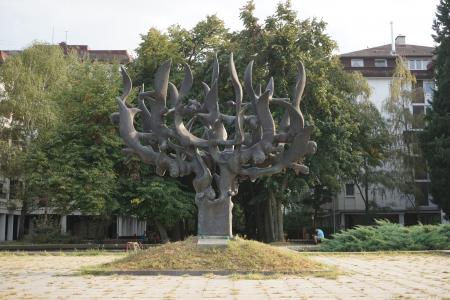Obj. ID: 7627
Modern Jewish Art Monument to Jewish Victims of Nazi Genocide in Belgrade and Serbia, Belgrade, Serbia, 1990

Name of Monument
Menora u plamenu
Translation: The Menorah in Flames
Description
The bronze free-standing sculptural monument in the shape of a menorah, is located on the banks of the Danube River in Belgrade's Dorćol neighborhood in a small paved plaza surrounded by a playground, apartments houses and the riverside walkway. The monument is composed of a tall sculpture (approximately 4-5m) in the shape of a menorah where the branches extend like flame-like tendrils. Human arms and heads, seeming to writhe in agony, protrude from the sculpture.
In the words of Irina Subotić, the chronicler of Glid’s work “The monument is shaped like a hand opened wide, made up of intertwined human bodies wishing to soar like birds and escape death and the flames.”
Zoran Markus wrote. "the flame of the fire of many Phoenixes is intertwined with human skeletons, arms and legs in a deathly spasm, as an emblem of resurrection and triumph of light and life over death and darkness",
At the base of the monument is a mental plaque that contains an identical inscription in three languages, Serbian, English, and Hebrew.
Inscriptions
The inscription in three languages is identical.
Serbian:
ЈEBPEJИМA, ЖPTBAMA HAЦИCTИCTИЧКОГ ГEHOЦИДА
У БЕОГРАДУ И СРБИЈИ 1941-1944
HAPOД CPБИЈЕ, ГРАД БЕОГРАД, ОПШТИНА СТАРИ ГРАД
И ЈЕВРЕЈСКА ОПШТИНА.
21.10.1990
English:
TO JEWISH VICTIMS OF NAZI GENOCIDE IN BELGRADE
AND SERBIA, 1941-1944.
PEOPLE OF SERBIA, CITY OF BELGRADE, MUNICIPALITY OF STARI GRAD
AND THE JEWISH COMMUNITY.
21.10.1990
Hebrew:
לקורבנות השואה היהודים בבלגרד ובסרביה 1941-1944
האנדרטה הוקמה ע''י העם הסרבי, עיריית בלגרד, מועצה מקומית סטארי
גרעד והקהילה היהודית בבלגרד
21.10.1990
Commissioned by
Jewish Community of Belgrade, The City of Belgrade, Municipality of Stari Grad
sub-set tree:
Initial NG with the date 1990 in raised letters on bronze trunk of monument (see photo)
There were approximately 12,000 Jews in Belgrade before the war, and as few as 1,000 by its end. The Nazis were so confident about their elimination of the Jews in Belgrade that this was the first major European city which they declared to be "Judenfrei" or "free of Jews". This monument is dedicated to those lost lives.
In 1989, in a period of rapid political change in Central and Eastern Europe, the Jewish community of Belgrade, together with intellectuals and artists,, proposed the creation of a monument to Holocaust victims in Belgrade. The monument was to be erected in the Dorćal district, which for centuries before the holocaust had been Belgrade’s Jewish quarter. The promotors proposed that the monument should be dedicated to all Jews killed in Belgrade during the Nazi period, where they were Belgraders or Jews transferred various Jewish communities in Kosovo Benat, Sandžak, and elsewhere.
A Committee was formed and began to raise funds. A solidarity sponsorship campaign was organized and included artists, work organizations, and citizens. Theatrical and musical performances and auctions of art were produced to raise money and attention. Funds came from a variety of local and international sources. In the end, basic financial support was provided by the city assembly of Belgrade.
In 1989, a commission engaged Yugoslav sculptor and Holocaust survivor Nandor Glid to create the monument in Belgrade, a task he had long desired. Glid, who had previously created powerful memorial sculptures at the Concentration Camps of Mauthausen and Dachau, had strong ties to Belgrade and its Jewish community. He was also among the most prominent Yugoslav artists. The resulting sculptural monument, called both Menorah from Dorćol or Menorah in Flames, was mounted on the Danube riverbank where Jevrejska [Jewish] Street meets the river. The location is close to the Dorćol neighborhood, where Sephardic Jews had been living for centuries since their arrival in Belgrade from Spain in the 15th and 16th centuries. It was from here that Belgrade’s Jews were taken to their deaths over a period of eleven months.
The monument was dedicated on October 21, 1990 in the presence of Yugoslav and foreign dignitaries. Jasa Almuli, President of the Jewish Community said "To us, the few Belgrade Jews left, the ceremony starting at this moment does not boil down to a mere act of unveiling a monument. We understand it as the first dignified burial of our dead, whose bodies were thrown into nameless graves. We shall now recite Kaddish [prayer for the dead], wave a last good-bye to our women and children. And even though we don't know their names or how many of them there were exactly, we inscribe them in our hearts and, instead of laying them to rest in their graves, we place them under the aegis of this monument", were the words of.”
The monument received praise from the Jewish community, survivors and artis. The sculptor and Auschwitz survivor Vida Jocić, and Stojan Kovačević Grande sent a telegram to Nandor Glid on 29th October 1990: "Your magnificent sculptural creation, the monument to Jews entitled Menorah, is a warning, means of ennoblement and a source of inspiration." The success of the monument led Glid top create several other versions that were erected in other locations, most notably in Thessaloniki in 1997.
Glid explained in several interviews that his design reconciled "my constant duality, theme and form, theme and expression, the dramatic and the tragic, that is, the lyrical. What I wished to present here was the symbol of Menorah in Flame, which proved resilient and survived the whirlwind of the war... I return to the theme of suffering here, only, I didn't want it to be depressive but to bring back hope, patience, germination, optimism... to be accepted by ordinary people as well — as an adornment, as a flower in a very nice part of Belgrade, attracting people rather than repulsing them... “ Quoted in I. Subotić, Nandor Glid (2012), p. 141.
Hostein, Lisa, “Yugoslavia. A Jewish community refuses to die", Jewish Exponent, Philadelphia. vol. 187, no. 5 (February 2, 1990): 32.
Markuš, Zoran, "Trijumf zivota. O umetnickim i kulturnim vrednostima Glidovog spomenika jevrejskim zrtvama [The Triumph of Life. On the Artistic and Cultural Values of Glid's Monument to Jewish Victims]", Politika (Belgrade). November 20, 1990.
Niebyl, Donald et al, Spomenik Database, https://www.spomenikdatabase.org/belgrade (accessed April 10, 2024)
Pisarri, Milovan Rena Rädle, Mesta stradanja I antifasisticke borbe u Beogradu 1941-44 (Belgrade: Rosa Luxemburg Stiftung Southeast Europe, 2013)
Rajner, Maria, Jevrejska groblja u Beogradu, Zbornik Jevrejskog istorijskog muzeja 6 (1992): 21.
Sefardski Beograd / Belgrado Sefardi / Sephardic Belgrade, Free Map and Guide (Belgrade: Instituto Cervantes, 2022)
"Spomenik zrtvama Menora u plamenu u Beogradu [A Monument to Victims, Menorah in Flame, to Be Erected in Belgrade]", Bilten Udruzenja Jevreja Jugoslavije u Izraelu (Tel Aviv). 38 (6) (December 2, 1990).
Subotic, Jelena, "Spomenik jevrejskim zrtvama. Akcija za istoriju [A Monument to Jewish Victims. A Historic Campaign]", Politika (Belgrade). January 29, 1990.
Subotić, Irina, Nandor Glid (Belgrade: Fondacija Vujičić koleccija, 2012).











